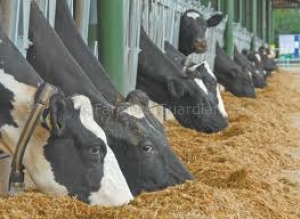Dairy Experts

“Dry conditions across parts of the upper Midwest strained crop production during the 2012 growing season,” North Dakota State University Extension Service beef specialist Carl Dahlen says. “In many areas, late-season crops such as corn and soybeans took the brunt of this reduction in yield. However, cool-season cereal grains fared much better than their warm-season counterparts.”
To take advantage of fall, winter and spring precipitation, producers should plant winter wheat, winter triticale or fall rye this fall for chopping and ensiling in 2013. These cereal grains likely would be ready to cut by the beginning of June 2013, which would help producers meet at least a portion of their feed needs for the 2013 fall and winter feeding seasons, Mr Dahlen adds.
The optimum time for seeding winter cereals in Minnesota and North Dakota is September 10-30 south of Interstate 94 and September 1-15 north of the interstate. Delaying planting past the optimum seeding date increases the risk for winterkill. However, seeding too early can result in excessive growth in the fall, making plants more vulnerable to winterkill and exposing the seedlings to a number of diseases and pests.
The wheat streak mosaic virus (WSMV), for example, has become an increasing problem in western North Dakota in recent years. The best way to avoid WSMV infections in the fall is to break the green bridge by destroying all of the volunteer wheat at least two weeks before planting winter wheat and delaying planting. For more information on the risks of the WSMV across western North Dakota, contact the Extension area cropping system specialists at NDSU’s Research Extension Centers near Dickinson and Minot.
Fall rye is the most winter-hardy, followed by winter wheat and winter triticale, according to Jochum Wiersma, University of Minnesota small-grains specialist and an adjunct professor in NDSU’s Plant Sciences Department. The more winter-hardy the variety, the more latitude you have to delay the planting past the optimum planting date.
He recommends no-till seeding winter cereals into standing crop stubble to retain snow during the winter. Snow insulates, protecting the crown of the winter wheat from the potentially lethal winter temperatures. No-till seeding also preserves the little moisture left in the soil.
Winter cereals should be seeded 1 to 1 1/2 inches deep to encourage rapid emergence. Seeding shallower than 1 inch will create a higher winterkill risk.
The optimum stand of winter cereals is 900,000 to 1 million plants per acre, or 21 to 23 plants per square foot. This would be equivalent to roughly 90 to 100 pounds of seed per acre. Producers should increase the stand to 23 to 25 plants per square foot if delaying planting or the seedbed is very dry or lumpy, making good seed-to-soil contact difficult to achieve.
“Some winterkill always should be expected,” Mr Wiersma says. “In the spring, do not be too quick to destroy stands that appear to have experienced winterkill. Wait until the plants break dormancy and fields begin to green up in the spring. You may have to wait until the end of April before you can determine the degree of winterkill. Evaluate fields and determine whether stands have at least 17 plants per square foot. If so, these stands still can produce near maximum forage yield.”
Fertilizer N (nitrogen) applications should be split, with 30 to 40 pounds of N per acre applied in the fall and the remainder top-dressed in early spring. Using a starter fertilizer such as MAP or DAP in combination with some potash in the fall will provide the crop with the nutrients it needs to get established well and maximize winter hardiness. Limit the amount of in-furrow fertilizer to 20 to 30 pounds of N and K2O (potassium oxide) combined to reduce seedling damage.
For help in determining the proper fertilizer application rate for your fields or with soil testing, contact your local Extension personnel or a qualified crop consultant.
The primary weed problems in winter cereals are annual weeds such as biennial wormwood, field pennycress and shepherd’s purse, and perennial weeds such as Canada thistle, quackgrass and perennial sow thistle. Use a fall burn-down application of herbicide prior to planting to control emerged winter annual weeds, volunteer crops and perennial weeds.
Consider most winter wheat varieties to be susceptible to diseases such as tan spot, powdery mildew, and leaf and stripe rusts. Fall rye and triticale generally are less susceptible to these fungal pathogens. Wiersma advises using half the labeled rate of a fungicide in early May to control any of these fungal pathogens because they will reduce total biomass and feed quality, especially if you no-till seed into wheat or barley stubble. Check the product label for preharvest interval restrictions prior to application.
When harvesting, expect the total dry-matter production of the winter cereals to equal or exceed that of spring wheat and spring triticale.
Cutting the winter cereals for silage at the boot stage allows for double cropping because the crop will reach the boot stage by the last week of May or first week of June and the milk stage two to three weeks later. After removing the cereal crops, consider planting mixes of cover crops for late-season grazing or other crops such as sorghum, sudan grass or sorghum-sudan grass.
Winter cereals harvested at the boot stage have a moisture content of about 80 per cent and will have to be wilted to get them down to the target moisture of 60 to 65 per cent. Small grains have hollow stems and are more difficult to pack than corn silage, so they should be cut finer (3/8 to 1/2 inch).
Delaying the harvest until the late dough stages of growth increases the chances of poor ensiling because packing the silage becomes more difficult. The potential benefits of using inoculants to optimize silage fermentation are greater with small-grain silages than for corn silage because microbial populations often are low at the time when cereal grain silages would be harvested.






















